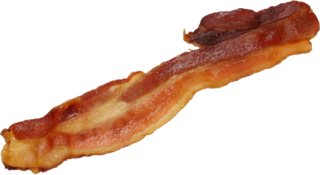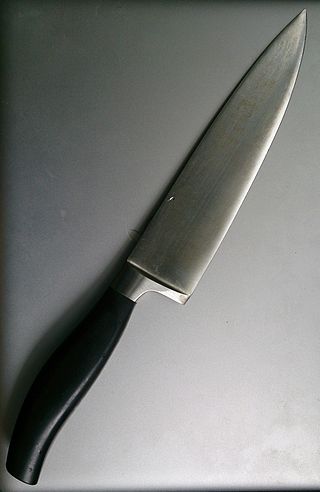
Pasta is a type of food typically made from an unleavened dough of wheat flour mixed with water or eggs, and formed into sheets or other shapes, then cooked by boiling or baking. Pasta was traditionally only made with durum, although the definition has been expanded to include alternatives for a gluten-free diet, such as rice flour, or legumes such as beans or lentils. Pasta is believed to have developed independently in Italy and is a staple food of Italian cuisine, with evidence of Etruscans making pasta as early as 400 BCE in Italy.

Spaghetti is a long, thin, solid, cylindrical pasta. It is a staple food of traditional Italian cuisine. Like other pasta, spaghetti is made of milled wheat, water, and sometimes enriched with vitamins and minerals. Italian spaghetti is typically made from durum-wheat semolina. Usually the pasta is white because refined flour is used, but whole wheat flour may be added. Spaghettoni is a thicker form of spaghetti, while spaghettini is a thinner form. Capellini is a very thin spaghetti, while vermicelli refers to intermediate thicknesses.

Sashimi is a Japanese delicacy consisting of fresh raw fish or meat sliced into thin pieces and often eaten with soy sauce.

Bacon is a type of salt-cured pork made from various cuts, typically the belly or less fatty parts of the back. It is eaten as a side dish, used as a central ingredient, or as a flavouring or accent. Regular bacon consumption is associated with increased mortality and other health concerns.

The Atkins diet is a low-carbohydrate fad diet devised by Robert Atkins in the 1970s, marketed with claims that carbohydrate restriction is crucial to weight loss and that the diet offered "a high calorie way to stay thin forever".

A peeler is a kitchen tool, a distinct type of kitchen knife, consisting of a metal blade with a slot with a sharp edge attached to a handle, used to remove the outer layer of some vegetables such as potatoes, broccoli stalks, and carrots, and fruits such as apples and pears. A paring knife may also be used to peel vegetables. The blade of a peeler has a slot with one side sharpened; the other side of the slot prevents the blade from cutting too far into the vegetable.

The zucchini, courgette or baby marrow is a summer squash, a vining herbaceous plant whose fruit are harvested when their immature seeds and epicarp (rind) are still soft and edible. It is closely related, but not identical, to the marrow; its fruit may be called marrow when mature.

Kitchenware refers to the tools, utensils, appliances, dishes, and cookware used in food preparation and the serving of food. Kitchenware can also be used to hold or store food before or after preparation.

Comfort food is food that provides a nostalgic or sentimental value to someone and may be characterized by its high caloric nature associated with childhood or home cooking. The nostalgia may be specific to an individual or it may apply to a specific culture.

A kitchen knife is any knife that is intended to be used in food preparation. While much of this work can be accomplished with a few general-purpose knives — notably a large chef's knife and a smaller serrated blade utility knife — there are also many specialized knives that are designed for specific tasks such as a tough cleaver, a small paring knife, and a bread knife. Kitchen knives can be made from several different materials, though the commonest is a hardened steel blade with a wooden handle.

In cooking, a chef's knife, also known as a cook's knife, is a cutting tool used in food preparation. The chef's knife was originally designed primarily to slice and disjoint large cuts of beef and mutton. Today it is the primary general utility knife for most Western cooks.

The santoku bōchō(Japanese: 三徳包丁, — lit. "three virtues knife" or "three uses knife") or bunka bōchō(文化包丁) is a general-purpose kitchen knife originating in Japan. Its blade is typically between 13 and 20 centimetres long, and has a flat edge. The santoku has a sheep's foot-tipped blade that curves down an angle approaching 60 degrees at the point. The bunka bōchō, however, has a k-tip. The term santoku may refer to the wide variety of ingredients that the knife can handle: fish, meat, and vegetables, or to the tasks it can perform: chopping, dicing, and slicing, with either interpretation indicating a multi-use, general-purpose kitchen knife. The term bunka, refers to how it is used for the cultural food of Japan. The blade and handle of the santoku are designed to work in harmony by matching the blade's width and weight to the weight of the tang and the handle.

A pizza cutter is a handheld kitchen utensil that is used to cut various items into sections or slices. Due to its prevalence in the making of pizza, it has earned the name "pizza cutter". The typical pizza cutter has a wheel-shaped blade that is attached to a handle. The original design has been modified over the years to include different sizes, blades, handles, and uses. The typical pizza cutter is not limited to cutting pizza but also for a variety of other tasks such as cutting dough or chopping herbs.

A cleaver is a large knife that varies in its shape but usually resembles a rectangular-bladed hatchet. It is largely used as a kitchen or butcher knife and is mostly intended for splitting up large pieces of soft bones and slashing through thick pieces of meat. The knife's broad side can also be used for crushing in food preparation and can also be used to scoop up chopped items.

Chicken parmesan or chicken parmigiana is a dish that consists of breaded chicken breast covered in tomato sauce and mozzarella, Parmesan or provolone. Ham or bacon is sometimes added.

Neapolitan cuisine has ancient historical roots that date back to the Greco-Roman period, which was enriched over the centuries by the influence of the different cultures that controlled Naples and its kingdoms, such as that of Aragon and France.

Vegetable chips are chips (crisps) that are prepared using vegetables other than potatoes. Vegetable chips may be fried, deep-fried, dehydrated, dried, or baked. Many different root vegetables or leaf vegetables may be used. Vegetable chips may be eaten as a snack food and may accompany other foods such as dips, or be used as a topping on dishes. In the United States, vegetable chips are often mass-produced, with many brands marketed to consumers.
TikTok food trends are specific food recipes and food-related fads on the social media platform TikTok. This content amassed popularity in 2020 during the COVID-19 pandemic, given that many were inclined to eat at home while simultaneously turning to social media as a form of entertainment. While some TikTok users share their diets and recipes, others expand their brand or image on TikTok through step-by-step videos of easy and popular recipes. Users often refer to food-related content as "FoodTok."


















